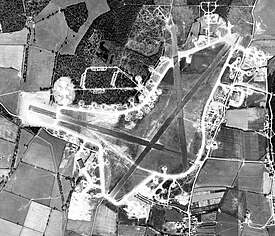RAF Grafton Underwood
| RAF Grafton Underwood USAAF Station 106 |
|
|---|---|
| Located Near Kettering, Northamptonshire, England | |

Aerial photograph of Grafton Underwood airfield. The bomb dump is to the north of the perimeter track on the west side of the airfield. 22 April 1944. Note the large number of 384th Bomb Group B-17s on hardstands.
|
|
| Coordinates | 52°25′15″N 000°38′59″W / 52.42083°N 0.64972°W |
| Type | Military airfield |
| Code | GU |
| Site information | |
| Controlled by |
Royal Air Force United States Army Air Forces |
| Site history | |
| Built | 1941 |
| In use | 1941–1959 |
| Battles/wars |
European Theatre of World War II Air Offensive, Europe July 1942 – May 1945 |
| Garrison information | |
| Garrison |
RAF Bomber Command Eighth Air Force |
Royal Air Force Grafton Underwood or more simply RAF Grafton Underwood is a former Royal Air Force station located 4 miles (6.4 km) northeast of Kettering, Northamptonshire, England.
The airfield was opened in 1941 and was first used by the RAF Bomber Command No. 1653 Heavy Conversion Unit RAF with Consolidated Liberators. The original runways were approximately 1,600 yards and 1,100 yards in length. However, these were unsuitable for the operation of heavy, four-engined bombers and the field was upgraded to Class A airfield standards, including the lengthening of the runways to the required 2,000 yards for the main and 1,400 yards for each of the others, started in late 1942.
Grafton Underwood was assigned United States Army Air Forces Eighth Air Force in 1942. Its designation was USAAF Station 106.
USAAF Station Units assigned to RAF Grafton Underwood were:
Regular Army Station Units included:
The first United States Army Air Forces Eighth Air Force tenant on Grafton Underwood was the 15th Bombardment Squadron, arriving on 12 May 1942 from Batchelor, Australia. The squadron flew the British Boston III light bomber. The 15th was originally part of the 27th Bombardment Group (Light), based in the Philippine Islands, however the group's planes (A-24's), did not arrive by 7 December 1941. Due to the deteriorating situation in the Philippines after the Japanese attack, they were diverted to Australia where they reformed into a combat unit and fought in the Dutch East Indies and New Guinea Campaigns.
...
Wikipedia


